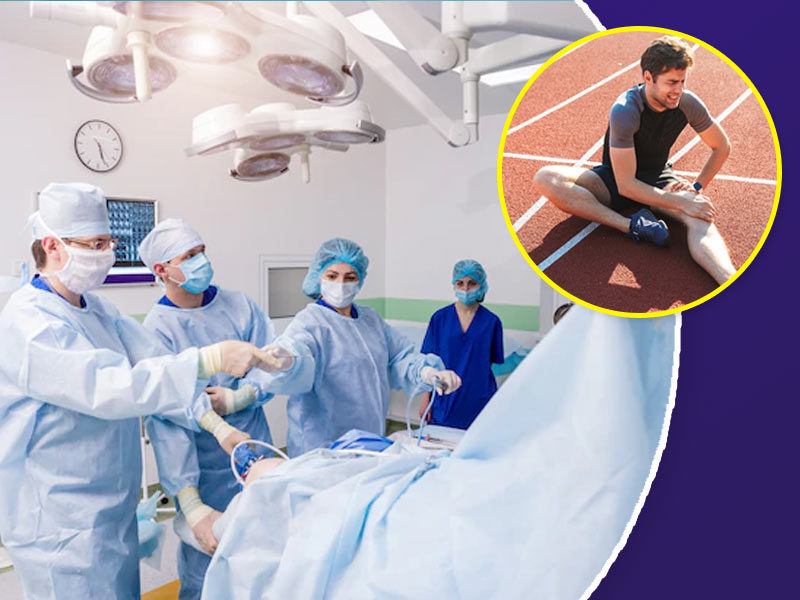
Injuries are part of life if you are physically active. But when you are into sports or an athlete, you cannot let injuries hamper your performance. Joint pain and joint wear and tear are quite common with athletes but it is important to get them treated. Normal pain can be treated with OTC medicines and ointments but if you suffer from a major injury that needs surgical intervention, it is suggested to explore all options. These days, people prefer minimally invasive surgical procedures like arthroscopy. This surgery diagnoses problem with your joints, mainly knees and provide effective treated. In this article, Dr. Ankit Varshney, Senior Consultant Orthopaedics; Arthroscopy, Sports Medicine & Shoulder surgeon at Sant Parmanand Special Surgery Hospital, New Delhi explains all about arthroscopic surgery, how it is done and why it is useful for treating knee joint-related problems.
Table of Content:-
What is arthroscopy surgery?
Arthroscopic surgery or arthroscopy, is a medical procedure used only by orthopaedic surgeons to analyse joints, identify problems, and treat them. Its minimally invasive technique has developed for the treatment and healing of joint damage. Patients may benefit with reduced hospital, quicker recovery times, and less scarring. Arthroscopic surgery is treating patients who get back on their feet, from ankles and wrists to knees and shoulders.

Also Read: Tips For Rehabilitation After Knee Replacement Surgery
Arthroscopic knee surgery procedure
If you are wondering how is this surgery done in minimally invasive manner which makes it safe for people who do not want to get large surgical incisions done. Here is the step-by-step procedure of arthroscopic surgery as explained by Dr. Varshney:
- An orthopaedic specialist will make small cuts near the problematic joint, about 14 feet in diameter, undergoing arthroscopic surgery.
- The surgeon will then put a sterile fluid into one of the holes, inflating the joint and offering a better view as well as more working space.
- A small tube containing fiber optics and lenses is then put into one of the holes by the surgeon. This tube is called arthroscope.
- The arthroscope is connected to a video camera, allowing the interior of the joint such as the ligaments and cartilage to be enlarged and presented on a television screen.
- Arthroscopes available in a multitude of sizes, based on the joint they're used on.
- The arthroscope is about 5 mm in diameter if the doctor is looking at a knee. It could be as little as 0.5mm in diameter for a wrist.
- On the video screen, the doctor will be able to see what is happening beneath the epidermis.
- If you're having an arthroscopy to diagnose a problem, the incisions will be closed with easily absorbed or non-absorbable sutures as quickly as the surgeon is certain of the problem's cause.
- Small devices will be put through the holes to repair the problem if the operation is being performed to treat a diagnosed problem.
- From anchoring sutures to the bone to making knots, these tools are specialised for every task.
- The surgeon will close the incisions with sutures once the project is completed.
Also Read: Why Are Degenerative Knee Problems Rising In Younger Adults

Arthroscopy benefits
One of the major benefits of arthroscopic surgery is that this doesn’t require to fully open up the joint. The surgeon puts a small cut and identify the root cause of the problem and provide needful treatment.
Arthroscopic is used to treat knee, Knee osteoarthritis, Meniscal tears, Hip, Shoulder, Wrist, Spine and Temporomandibular joint. This procedure is beneficial because of the following reasons:
- Scar and incision size are both smaller.
- Less blood loss means a faster recovery.
- Infection risk is reduced.
- Reduces discomfort and the need for pain drugs.
- Outpatient procedures are about to begin.
- Minimizes pain/need for pain medications
- About to be performed in outpatient settings
Conclusion
Inflammation, damaged ligaments and tendons, loose bone or cartilage, and even some diseases can all be treated by arthroscopic surgery. If a patient is having a joint issue, there is a good chance arthroscopic surgery can diagnose and treat it. Arthroscopies are most commonly performed on the knee and shoulder, however they can be performed on any joint.
Image credits- freepik
Also watch this video
Read Next
World Health Day 2022: How Can Environment Affect Our Health? Here Are Expert Tips To Deal With It
How we keep this article up to date:
We work with experts and keep a close eye on the latest in health and wellness. Whenever there is a new research or helpful information, we update our articles with accurate and useful advice.
Current Version